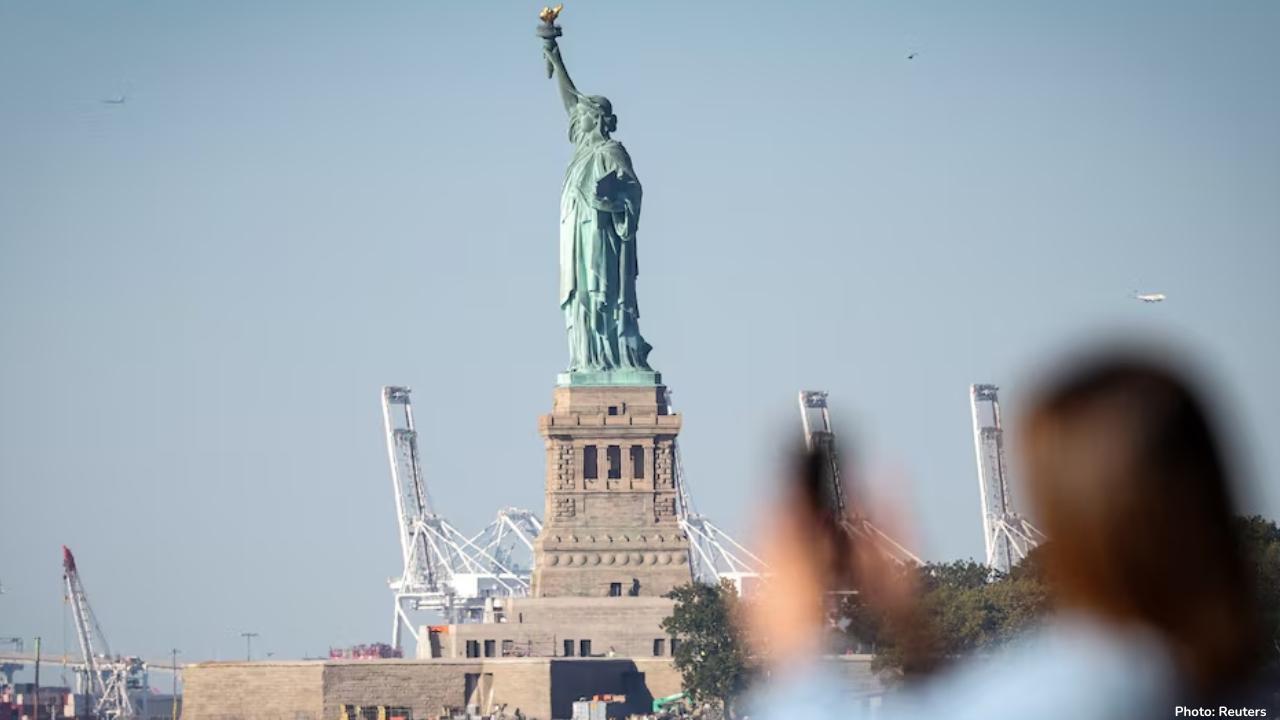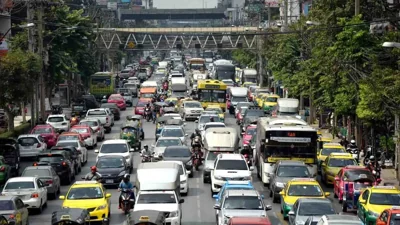
Post by : Monika
On October 1, 2025, the United States government entered a partial shutdown after Congress failed to approve a spending bill to fund federal operations. This shutdown marks the 15th such event in the United States since 1981 and has caused major disruptions for hundreds of thousands of federal employees and numerous government services.
Why the Shutdown Happened
The shutdown occurred because lawmakers in Congress could not agree on a temporary spending bill, known as a stopgap measure, before the new fiscal year began on October 1. This type of bill is meant to provide short-term funding for government operations while longer-term budget negotiations continue.
The Senate did not pass the bill because of disagreements between Republican and Democratic lawmakers over spending priorities. Republicans pushed for limited federal spending and strict controls on budget deficits, while Democrats wanted more funding for social programs, green-energy projects, and transit initiatives in several states. Because these disagreements could not be resolved in time, most federal government operations were suspended.
Impact on Federal Workers
Approximately 750,000 federal employees have been affected by the shutdown. Some of these workers have been furloughed, which means they are temporarily put on leave without pay. Others, such as military personnel, border patrol agents, air traffic controllers, and emergency responders, are required to continue working but will not receive their paychecks until the government reopens.
Vice President JD Vance has warned that if the shutdown continues for several weeks or months, additional layoffs may occur. This could potentially affect up to 300,000 more federal workers by December, creating financial strain for families who rely on steady government salaries.
Many federal employees have expressed concern and frustration over the uncertainty. Workers in agencies like the Internal Revenue Service (IRS) have had to delay important administrative work, while those in federal research programs may face setbacks in ongoing projects. The shutdown has left many employees uncertain about their financial stability and their ability to meet everyday expenses.
Suspension of Government Services
The shutdown has led to the suspension of numerous government services and operations. Several key agencies have furloughed most of their staff, which has affected both regulatory activities and public services.
For example, the Federal Communications Commission (FCC) furloughed 81% of its staff. This reduction means many licensing and communication approvals are delayed, impacting telecommunications companies and consumers alike.
The Securities and Exchange Commission (SEC) furloughed more than 90% of its employees. As a result, the processing of initial public offerings (IPOs), oversight of financial markets, and other regulatory functions have slowed down. Investors and companies seeking regulatory approval for business transactions may experience delays, creating uncertainty in financial markets.
Other agencies, such as the Consumer Financial Protection Bureau (CFPB), continue to operate because they have independent funding not tied to congressional appropriations. While some services remain active, the overall effect of the shutdown has caused disruptions across many government functions.
Political Repercussions
The shutdown has intensified political tensions in Washington. President Donald Trump used the situation to freeze $26 billion in federal funds allocated to Democratic-led states. This includes $18 billion for transit projects in New York and $8 billion for green-energy initiatives in states like California and Illinois.
Democratic leaders strongly criticized these actions, accusing the administration of using the shutdown as a political weapon to target states that do not share the same priorities as the federal government. Lawmakers from both parties are under pressure from constituents to resolve the deadlock quickly, as the shutdown affects everyday services and the financial security of federal workers.
Economic Consequences
The partial government shutdown has already begun to affect the U.S. economy. Financial markets have experienced volatility, with Wall Street futures showing declines and the U.S. dollar weakening against other major currencies. Investors often move money to safe assets during periods of uncertainty, causing gold prices to reach record highs.
In addition, the suspension of regulatory activities by agencies like the SEC and the Commodity Futures Trading Commission (CFTC) has raised concerns. Delays in financial oversight could potentially slow down investments, mergers, and business transactions, affecting both domestic and international companies.
Local businesses and federal contractors are also feeling the impact. Companies that rely on government contracts may face delayed payments, which could affect their operations and cash flow. The shutdown may also affect public services like national parks, federal research programs, and infrastructure projects, slowing down progress and limiting access for citizens.
Travel and Transportation
Certain federal services related to travel and transportation have also been impacted. For example, delays in air traffic management, airport security, and federal oversight of transportation projects may occur, although critical safety operations continue. Agencies like the Department of Transportation have furloughed staff in administrative and planning roles, which could slow approvals for new projects.
Additionally, transit projects funded through federal grants in several states may face delays due to frozen funds. This may affect the construction of new subway lines, highway repairs, and other infrastructure initiatives. For citizens who rely on these projects, the shutdown may cause inconvenience and slower improvements in public services.
Looking Ahead: Duration and Resolution
The duration of the shutdown is uncertain. Negotiations are ongoing, but no clear agreement has been reached yet. Lawmakers face increasing pressure to pass a funding bill to reopen the government and restore normal operations.
If the shutdown continues for several weeks, it could have broader impacts on federal employees, public services, and the economy. Federal workers may face extended periods without pay, regulatory agencies may delay critical operations, and investor confidence in the U.S. economy could weaken further.
Experts suggest that the sooner Congress reaches a compromise, the better it will be for federal employees, businesses, and the overall economy. Historically, government shutdowns in the United States have ended when lawmakers agree on a temporary or full-year spending bill. However, the political divide between parties often prolongs these shutdowns, as each side seeks to advance its priorities.
Public Reaction
The public reaction to the shutdown has been mixed. Many citizens express concern over the impact on government services, such as delays in processing federal loans, social security benefits, or public health initiatives. Families with federal employees are particularly worried about financial difficulties during the period without pay.
At the same time, some voters blame political leaders for failing to compromise. Opinion polls suggest that prolonged shutdowns can affect the popularity of lawmakers and influence upcoming elections, as citizens tend to hold politicians accountable for disruptions to essential services.
Long-Term Implications
Repeated government shutdowns can have lasting effects. They can reduce public trust in government institutions, delay critical research and infrastructure projects, and create uncertainty in the financial markets. For federal employees, repeated shutdowns can lead to financial instability and lower morale, potentially affecting productivity even after operations resume.
Economists also warn that prolonged shutdowns may slow economic growth. Delays in federal spending, grant distribution, and public infrastructure projects can have ripple effects throughout the economy, affecting both small businesses and large corporations.
The U.S. government shutdown that began on October 1, 2025, highlights ongoing political disagreements in Congress and their consequences for the country. With hundreds of thousands of federal employees affected, key government services suspended, and financial markets experiencing uncertainty, the situation underscores the importance of timely budget agreements.
Federal workers face uncertainty about pay, agencies struggle to continue operations, and citizens encounter delays in essential services. Meanwhile, political tensions remain high, as lawmakers debate spending priorities and negotiate solutions.
The longer the shutdown continues, the greater its impact will be on employees, citizens, and the economy. Both political parties face pressure to reach an agreement and restore government funding to ensure that operations can return to normal.
This shutdown serves as a reminder of the challenges in balancing federal budgets, negotiating between different political agendas, and maintaining public services during times of government gridlock. Resolving the deadlock will be critical to supporting federal workers, stabilizing the economy, and ensuring that citizens have access to essential government functions.










Traffic Control Measures Announced for A.R. Rahman Concert at IGI Stadium
Delhi Traffic Police introduces measures near IGI Stadium for A.R. Rahman's concert on Saturday even

Kim Woo-bin and Shin Min-a Tie the Knot After a Decade Together
Actors Kim Woo-bin and Shin Min-a celebrated their marriage in an intimate ceremony in Seoul, markin

Rohit Sharma Set to Play Initial Matches in Vijay Hazare Trophy for Mumbai
Rohit Sharma joins Mumbai’s squad for the opening two Vijay Hazare Trophy matches, spearheaded by Sh

Flight Disruptions at King Khalid International Airport
Friday's operations at King Khalid Airport in Riyadh were hampered by delays and cancellations due t

Kavem Hodge Achieves Second Test Century Against New Zealand
Kavem Hodge's unbeaten century leads West Indies to 381-6, evading follow-on against New Zealand in

Security Heightened in Bangladesh Following Youth Leader's Assassination
In response to the murder of youth leader Sharif Osman Hadi, Bangladesh elevates security measures a